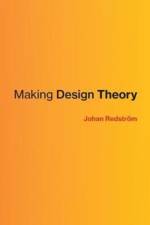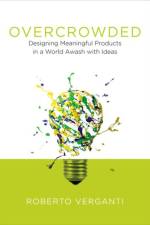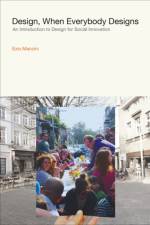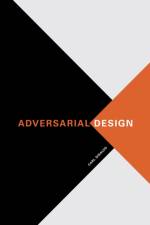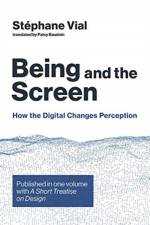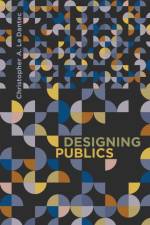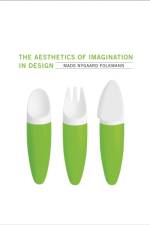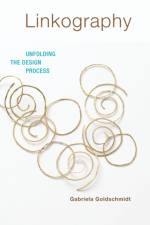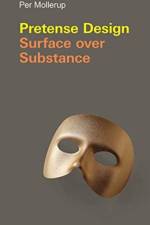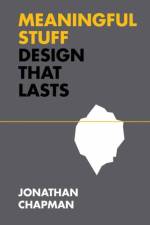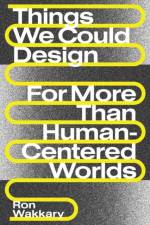Bøger i Design Thinking, Design Theory serien
-
418,95 kr. A new approach to theory development for practice-driven research, proposing that theory is something made in and through design.Tendencies toward "academization” of traditionally practice-based fields have forced design to articulate itself as an academic discipline, in theoretical terms. In this book, Johan Redström offers a new approach to theory development in design research-one that is driven by practice, experimentation, and making. Redström does not theorize from the outside, but explores the idea that, just as design research engages in the making of many different kinds of things, theory might well be one of those things it is making.Redström proposes that we consider theory not as stable and constant but as something unfolding—something acted as much as articulated, inherently fluid and transitional. Redström describes three ways in which theory, in particular formulating basic definitions, is made through design: the use of combinations of fluid terms to articulate issues; the definition of more complex concepts through practice; and combining sets of definitions made through design into "programs.” These are the building blocks for creating conceptual structures to support design. Design seems to thrive on the complexities arising from dichotomies: form and function, freedom and method, art and science. With his idea of transitional theory, Redström departs from the traditional academic imperative to pick a side—theory or practice, art or science. Doing so, he opens up something like a design space for theory development within design research.
- Bog
- 418,95 kr.
-
- Designing Meaningful Products in a World Awash with Ideas
308,95 kr. A more powerful innovation, which seeks to discover not how things work but why we need things.The standard text on innovation advises would-be innovators to conduct creative brainstorming sessions and seek input from outsiders—users or communities. This kind of innovating can be effective at improving products but not at capturing bigger opportunities in the marketplace. In this book Roberto Verganti offers a new approach—one that does not set out to solve existing problems but to find breakthrough meaningful experiences. There is no brainstorming—which produces too many ideas, unfiltered—but a vision, subject to criticism. It does not come from outsiders but from one person's unique interpretation.The alternate path to innovation mapped by Verganti aims to discover not how things work but why we need things. It gives customers something more meaningful—something they can love. Verganti describes the work of companies, including Nest Labs, Apple, Yankee Candle, and Philips Healthcare, that have created successful businesses by doing just this. Nest Labs, for example, didn't create a more advanced programmable thermostat, because people don't love to program their home appliances. Nest's thermostat learns the habits of the household and bases its temperature settings accordingly.Verganti discusses principles and practices, methods and implementation. The process begins with a vision and proceeds through developmental criticism, first from a sparring partner and then from a circle of radical thinkers, then from external experts and interpreters, and only then from users.Innovation driven by meaning is the way to create value in our current world, where ideas are abundant but novel visions are rare. If something is meaningful for both the people who create it and the people who consume it, business value follows.
- Bog
- 308,95 kr.
-
- A Semiotic Theory for Graphic Design
465,95 kr. Semiotics concepts from a design perspective, offering the foundation for a coherent theory of graphic design as well as conceptual tools for practicing designers.Graphic design has been an academic discipline since the post-World War II era, but it has yet to develop a coherent theoretical foundation. Instead, it proceeds through styles, genres, and imitation, drawing on sources that range from the Bauhaus to deconstructionism. In FireSigns, Steven Skaggs offers the foundation for a semiotic theory of graphic design, exploring semiotic concepts from design and studio art perspectives and offering useful conceptual tools for practicing designers.Semiotics is the study of signs and significations; graphic design creates visual signs meant to create a certain effect in the mind (a "FireSign”). Skaggs provides a network of explicit concepts and terminology for a practice that has made implicit use of semiotics without knowing it. He offers an overview of the metaphysics of visual perception and the notion of visual entities, and, drawing on the pragmatic semiotics of the philosopher Charles Sanders Peirce, looks at visual experience as a product of the action of signs. He introduces three conceptual tools for analyzing works of graphic design—semantic profiles, the functional matrix, and the visual gamut—that allow visual "personality types” to emerge and enable a greater understanding of the range of possibilities for visual elements. Finally, he applies these tools to specific analyses of typography.
- Bog
- 465,95 kr.
-
- Bog
- 219,95 kr.
-
378,95 kr. - Bog
- 378,95 kr.
-
- How the Digital Changes Perception. Published in one volume with A Short Treatise on Design
308,95 kr. How digital technology is profoundly renewing our sense of what is real and how we perceive.Digital technologies are not just tools; they are structures of perception. They determine the way in which the world appears to us. For nearly half a century, technology has provided us with perceptions coming from an unknown world. The digital beings that emerge from our screens and our interfaces disrupt the notion of what we experience as real, thereby leading us to relearn how to perceive. In Being and the Screen, Stéphane Vial provides a philosophical analysis of technology in general, and of digital technologies in particular, that relies on the observation of experience (phenomenology) and the history of technology (epistemology). He explains that technology is no longer separate from ourselves—if it ever was. Rather, we are as much a part of the machine as the machine is part of us. Vial argues that the so-called difference between the real and the virtual does not exist and never has. We are living in a hybrid environment—which is both digital and nondigital, online and offline. With this book, Vial endows philosophical meaning to what we experience daily in our digital age.In A Short Treatise on Design, Vial offers a concise introduction to the discipline of design—not a history book, but a book built of philosophical problems, developing a theory of the effect of design.This book is published with the support of the University of Nîmes, France.
- Bog
- 308,95 kr.
-
95,95 kr. - Bog
- 95,95 kr.
-
333,95 kr. A theoretically informed investigation that relates the philosophies of aesthetics and imagination to understanding design practice.
- Bog
- 333,95 kr.
-
- Bog
- 558,95 kr.
-
- Surface Over Substance
258,95 kr. How some design appears to be something that it is not-by beautifying, amusing, substituting, or deceiving.
- Bog
- 258,95 kr.
-
- Design That Lasts
258,95 kr. "In a world suffocated by people and things, this book exposes why we throwaway things that still work, and shows how we can design products, services, and experiences that last"--
- Bog
- 258,95 kr.
-
- For More Than Human-Centered Worlds
413,95 kr. How posthumanist design enables a world in which humans share center stage with nonhumans, with whom we are entangled.Over the past forty years, designers have privileged human values such that human-centered design is seen as progressive. Yet because all that is not human has been depleted, made extinct, or put to human use, today's design contributes to the existential threat of climate change and the ongoing extinctions of other species. In Things We Could Design, Ron Wakkary argues that human-centered design is not the answer to our problems but is itself part of the problem. Drawing on philosophy, design theory, and numerous design works, he shows the way to a relational and expansive design based on humility and cohabitation. Wakkary says that design can no longer ignore its exploitation of nonhuman species and the materials we mine for and reduce to human use. Posthumanism, he argues, enables a rethinking of design that displaces the human at the center of thought and action. Weaving together posthumanist philosophies with design, he describes what he calls things--nonhumans made by designers--and calls for a commitment to design with more than human participation. Wakkary also focuses on design as "nomadic practices"--a multiplicity of intentionalities and situated knowledges that shows design to be expansive and pluralistic. He calls his overall approach "designing-with": the practice of design in a world in which humans share center stage with nonhumans, and in which we are bound together materially, ethically, and existentially.
- Bog
- 413,95 kr.
-
458,95 kr. Exploring how design can be used for good—prompting self-reflection, igniting the imagination, and affecting positive social change.Good design provides solutions to problems. It improves our buildings, medical equipment, clothing, and kitchen utensils, among other objects. But what if design could also improve societal problems by prompting positive ideological change? In this book, Bruce and Stephanie Tharp survey recent critical design practices and propose a new, more inclusive field of socially minded practice: discursive design. While many consider good design to be unobtrusive, intuitive, invisible, and undemanding intellectually, discursive design instead targets the intellect, prompting self-reflection and igniting the imagination. Discursive design (derived from “discourse”) expands the boundaries of how we can use design—how objects are, in effect, good(s) for thinking.Discursive Design invites us to see objects in a new light, to understand more than their basic form and utility. Beyond the different foci of critical design, speculative design, design fiction, interrogative design, and adversarial design, Bruce and Stephanie Tharp establish a more comprehensive, unifying vision as well as innovative methods. They not only offer social criticism but also explore how objects can, for example, be used by counselors in therapy sessions, by town councils to facilitate a pre-vote discussions, by activists seeking engagement, and by institutions and industry to better understand the values, beliefs, and attitudes of those whom they serve. Discursive design sparks new ways of thinking, and it is only through new thinking that our sociocultural futures can change.
- Bog
- 458,95 kr.

